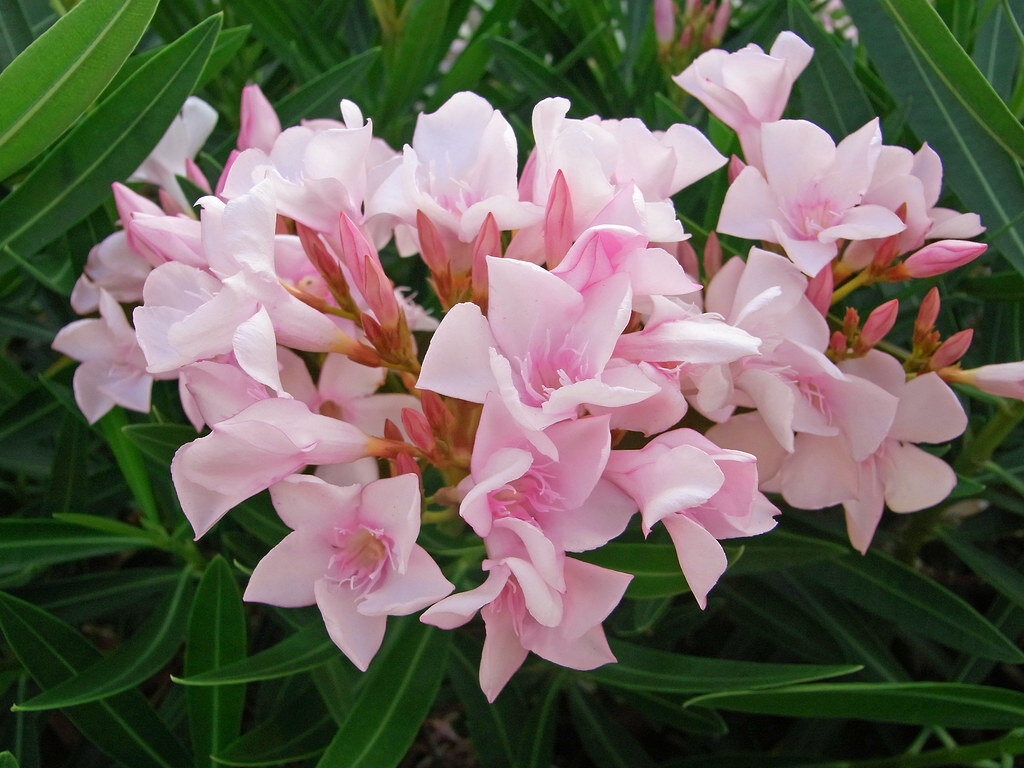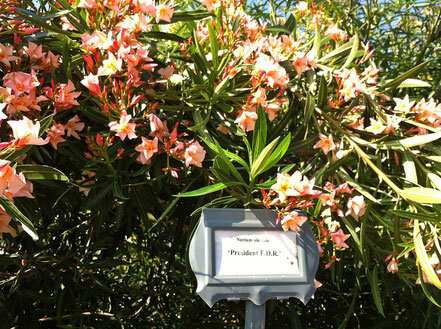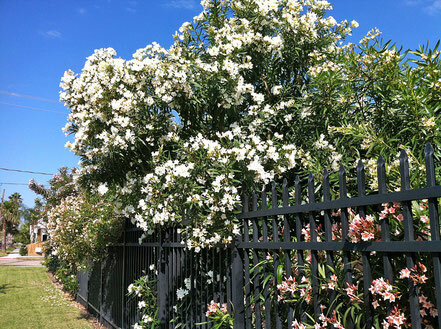Oleander
Tree Stories: Oleander
Is it a shrub or small tree? There is a plant common to Galveston that can behave as either, as varieties of the oleander (Nerium oleander) can range in height from four feet to over 20. These hardy plants that make Galveston the “Oleander City” are blooming now and will provide a blanket of color for months.
This large relative of the periwinkle is in the dogbane family (Apocynacea). The now-BOI first arrived in Galveston in the 1840s and became part of the replanting effort led by the Women’s Health Protective Association in the early 1900s. It is so widely cultivated that its origin is unknown, though it may be from southwest Asia. Evergreen oleanders are traditionally large, mounded shrubs whose quick growth rate and multi-stemmed habit work well for screens or hedges. Galveston College boasts numerous single trunked oleander “trees”, achieved through consistent pruning of side shoots.
Oleander is island-tough due to its drought- salt- and heat-tolerance, an ability to withstand occasional light frost (to 14-20°F), and adaptability to poor soils. Most survived Hurricane Ike with minimal impact. It prefers full sun and good drainage.
The resilient oleander is the official flower of the city of Hiroshima. It was the first to bloom following the atomic bombing of the city in 1945 and gave hope to the citizens of the devastated city.
Blossoms in a multitude of colors, some fragrant, appear from early summer through mid-autumn. Smooth, dark green leaves are thick and leathery. Fall pruning provides the new growth that produces spring flowers. The plant has few problems but occasionally the Botryosphaeria fungus will cause branches to die back, usually related to drought stress or freeze damage. Oleander caterpillars may feast on the plant and while that activity will not kill established specimens, defoliation may increase susceptibility to pests such as aphids, mealybugs and scales.
Despite oleander’s reputation as poisonous, from 1985 through 2005 only three human deaths were reported in the US, all individuals who for unknown reasons ingested large amounts of the plant. And don’t believe the urban legends, as there are no reports of families or scout troops accidentally poisoned by hot dogs roasted on oleander sticks over campfires. The flowers are nectarless, so honey is not contaminated by pollinators. However, the sap can cause skin and eye irritations and allergic reactions, and fumes from burning leaves are toxic. Of course anyone suspecting oleander poisoning should contact the poison control center.
Oleanders can add their color almost anywhere. Galveston’s Lydia Miller, President of the International Oleander Society, says dwarf and midsize varieties fit in even small gardens and are widely available. Many of these are blooming on Broadway esplanades or in the Society’s Oleander Garden Park at 2624 Sealy. Learn more at the upcoming Oleander Festival May 2&3 at Moody Gardens, and at http://oleander.org/.
It is easy to take oleanders for granted and they are often underappreciated. But with minimal care these tough survivors will produce blossoms that add beauty to our landscape for months to come.
“Tree Stories” is an ongoing series of articles about outstanding Island trees, tree care, and tree issues. If you have or know of a special tree on Galveston Island that should be highlighted, please email treesforgalveston@gmail.com. Margaret Canavan is a Galveston resident, a Galveston County Master Gardener, and a member of the Galveston Island Tree Conservancy Board.




